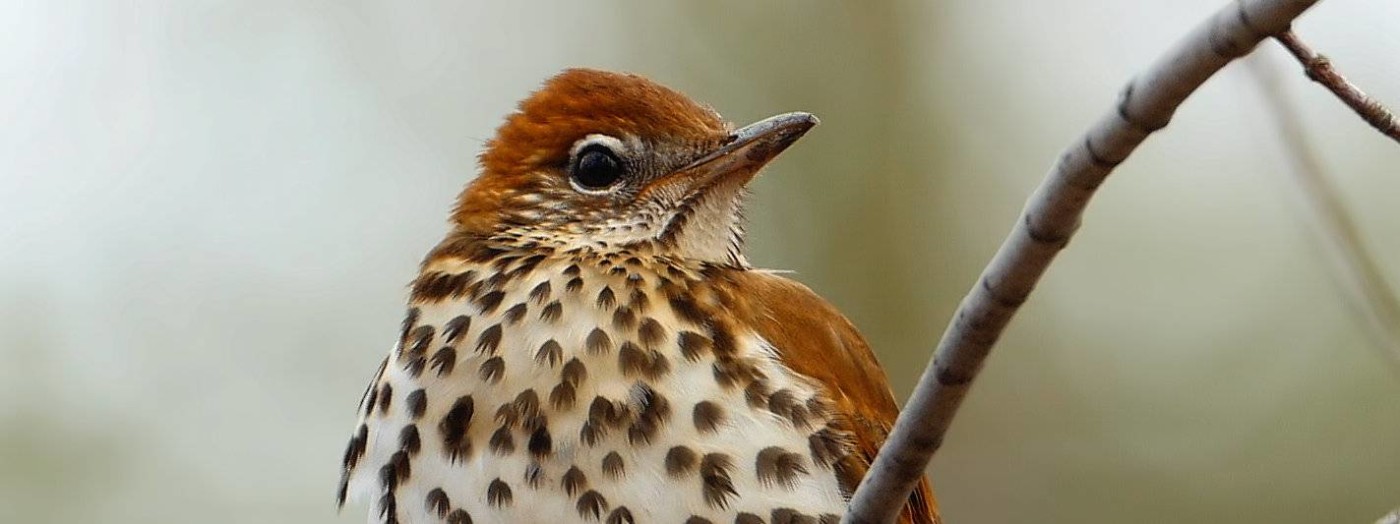Animals and Plants of the Finger Lakes
The Thrush in My Woods
It’s hard not to love a Wood Thrush — Thoreau called it “a Shakespeare among birds.” We know the Wood Thrush mostly by its strong, clear woodland song.
Frequently described as “flute-like,” the song of the Wood Thrush sounds more like bursts of sweet electronic music to my ears, especially in the buzzing trill at the end of each phrase. The haunting spring and summer music of these birds resonates through the trees from early morning until they seem to take a midday break. Later, in the evening, the Wood Thrush often sings until nightfall.
In my neck of the woods, on forested slopes above Owasco Lake, several breeding pairs around my house have stirred me for years. They return each May from winter grounds in Central America to nest and raise their young under the protection of the rich forest canopy and understory shrubs found throughout the Finger Lakes.

Although they are reputedly not secretive, I rarely glimpse the cinnamon-colored birds as they go about their daily routine, foraging for food in the moist leaf litter or building their nests of grass and fine strips of grapevine. Typically, Wood Thrushes in this area raise two broods each season, and gathering food is a full time job.
‘My’ Wood Thrushes, as I can’t help thinking of them, seem vigorous and prolific, yet I am aware of an accelerating decline in the overall population since the mid-1960s.
Radical deforestation of wintering grounds in Central America has taken a toll on their numbers. Also, forest fragmentation caused by human development has disrupted the Wood Thrushes’ traditional breeding ground here in North America. New roads, houses and commercial development have opened up previously undisturbed forest habitat to forest fringe predators such as raccoons, crows, jays, cowbirds, and house cats. Many songbird nest sites are at a greater risk as a result.
A 2002 Cornell study of Wood Thrush population decline, by Ralph Hames and others, pointed to an unexpected additional threat to the breeding success of these birds: acid rain.

According to the study, Wood Thrush numbers in the eastern U.S. have declined by more than 40 percent since 1980. The steepest declines have occurred in areas with the heaviest acid rainfall, especially in elevated forests of the Appalachians, as well as in the Adirondacks.
Acid rain and snow deplete the soil of calcium, putting a great strain on all organisms depending on calcium to survive and reproduce. Low on this food chain are snails and slugs, the preferred diet for breeding Wood Thrushes.
A steady supply of calcium-rich snails and slugs helps the female thrush produce strong egg shells. But where soil acidity is greatest, snail and slug populations do poorly, leading in turn to weakened egg shells and smaller clutches of eggs for the Wood Thrush. As the snail goes, so goes the thrush. Could the breeding success of other favorite song birds be in question as well?
Thoreau once wrote that, with its song, “The thrush alone declares the immortal wealth and vigor that is in the forest.” This is what I hear in my little piece of forest, too, but I catch a wistful note now and again.
This story by Eben McLane first appeared in our newsletter, The Land Steward, as part of the Closer Look series about plants and animals of the Finger Lakes region.





